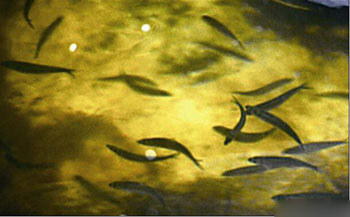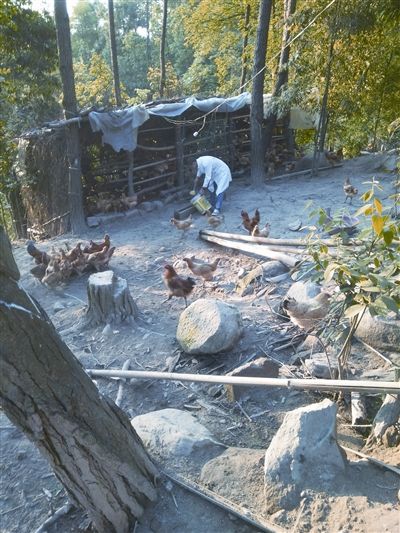"Factory culture" of shad 200 yuan a listed
Original title: 200 yuan each! The nearly extinct shad is back.

Factory farming has been a success in Jingjiang
The shad, which ranks first among the "three delicacies of the Yangtze River", is really a rare delicacy, especially the one produced near the lower reaches of the Yangtze River. It is a pity that since the 1980s, the wild shad on the Yangtze River has nearly disappeared. Recently, news came from Jingjiang. After a year of experiment by Shen Lian, a local "post-85" young man, "factory breeding" shad was successful recently, and 2000 fresh and plump shad began to go to the dining table of the public.
Large-scale culture
American shad "swim" to Jingjiang
In the two more than 10-meter-long cement ponds of Jingjiang Hai Love Aquaculture Base, thousands of shad are circling back and forth in groups. These fish are very interesting. They are in the same pace, either clockwise or counterclockwise together. Always so non-stop, immediately tumbled quickly and jumped out of the water after being affected by the sound of the outside world.
"the shad is a fish that never rests. It swims day and night and is called a 'perpetual motion machine on the water'." Shen Lian, the owner of the base, said that the shad's digestive system is fragile and its intestines are very short, so it needs to feed on plankton in constant movement and cannot stop for a moment.
In 2012, Shen Lian retired from the army and started an aquatic business, mainly engaged in medium-and high-grade seafood. Due to factors such as overfishing and the deterioration of the ecological environment, the resources of shad declined sharply, the output decreased year by year, and the individual miniaturization was serious, while the market demand increased unabated, even to the dilemma of having no market.
"the shad has such a market, wouldn't it be a good thing if it could be raised on its own?" Shen Lian immediately took action, and he learned that the American shad and the Yangtze River shad are "direct relatives" who live in similar environments and similar latitudes, and their appearance and taste are also very similar. In recent years, it has been introduced into China. As a substitute for shad in the Yangtze River, it has been cultivated on a large scale in Guangzhou and other places.
In March last year, under the guidance of the agricultural department, Shen Lian invested more than 1 million yuan to introduce 5000 American shad seedlings from Guangzhou and began artificial breeding.
Born delicate
2000 adult fish were harvested from 5000 fry
Shen Lian's shad breeding base is located in Shandong Village, Gushan Town, Jingjiang River, and is located in a secluded corner. Outsiders are usually not allowed to visit. It is not that these fish are unpopular, but because the shad is so delicate that if the shad moves in the slightest wind, it is possible to turn over its stomach and commit suicide and have to be left in an inaccessible place.
"Breeders have to work lightly on the edge of the pool, and if the shad is scared, it may bump into the wall of the pool and die." At the beginning of breeding, Shen Lian brought in 5000 fish fry, but when they were transported to Jingjiang, there were only 4000 fish fry left out of 5000. There was a thunder and rain in summer, and 500 tails turned their stomachs. During the cold wave in January this year, another 500 shad failed to withstand the low temperature and surfaced. Today, there are about 2000 shad left in the base.
When the shad was young, Shen Lian and his breeders hardly slept all night. Fortunately, it has now passed the critical period of breeding. Shen Lian said that these babies are very difficult to "serve." they are raised with recycled deep well water, and thermostats are installed in the greenhouse to keep the water temperature between 15 ℃ and 25 ℃. If they feed too much, they can only eat less and eat more. The shad has to be fed every hour or two during the day; the scales of the shad are very soft, and the nets used by the base are specially designed to minimize damage to the fish.
Worth a lot of money
200 yuan per piece is in short supply.
It is not too much to describe the shad after lifting the water, with a smooth spindle-shaped figure and sparkling scales all over the body. Because the shad keeps moving and consumes a lot of fat, the shad is much more fit than ordinary fish and contains a lot of unsaturated fatty acids. Fish scales, in particular, are high in phospholipids. Therefore, it is not scaly to eat shad.
What many gluttons are concerned about is that the wild shad tastes fresh and tender, but what is the taste of this artificially bred shad? Will it be a big loss of taste and lose the taste of the shad? Shen Lian said that the water quality of the base pool is very high, reaching the standard of direct drinking water. It is the shad that grew up in this special environment, with fresh and tender meat and a more delicate taste than the wild.
At present, the 2000 fish in the sea love aquaculture base have matured one after another, and the big ones have reached 2 jin. The shad in the base is not sold by jin, but by the bar, which is still in short supply. Each time, these shad were booked out by high-end restaurants in the surrounding area before they had time to go to the market.
In more than a month, the base will welcome another 20,000 shad fry. Shen Lian said that in the next step, the base will also explore and practice the artificial reproduction of the shad, and strive to make the farmed shad cheaper and cheaper and walk on the dining table of more and more people.
2 million fish fry were put into urban waters.
On the morning of May 20, the Fisheries Administration Detachment of the Municipal Agriculture Commission and the Fisheries Administration Brigade of Hailing District held activities for the proliferation and release of aquatic organisms in the waters near Wanghailou Wharf, Yinfeng River, and Taishan Park on the Fengcheng River. on the same day, a total of 2 million carp and Carassius auratus seedlings were released. This is also the largest number of fish fry released in inland rivers in our city over the years. More than 50 fishermen, netizens, representatives of fishing enthusiasts and fishery administration staff in Taizhou took part in the release of fish fry.
Carrying out the proliferation and release of fishery resources is an important measure in the construction of ecological civilization, which plays an important role in curbing water eutrophication, repairing and improving the ecological environment of water areas. and it will play a positive role in promoting the construction of a beautiful home where fish and water are close to each other and people and nature live in harmony.
It is reported that at present, there are more than 100000 fishing enthusiasts in our city, and their figures are often active on the banks of the Phoenix River, the Phoenix River, the Nanguan River and the Yinjiang River. On the same day, the relevant person in charge of the Municipal fishing Association also participated in the release activities, calling on all fishing enthusiasts to "stay big and release the small" in the process of fishing and develop the good habit of caring for the water resources environment and civilized fishing.
It is reported that around June 20, our city will release another 1.5 million fish fry into urban waters and 7 million fish fry into the Yangtze River. (reporter Sun Fengjuan)
- Prev

Fuling, Chongqing: the "Chicken Commander" of raising chickens with pine needles and bamboo leaves
Fuling, Chongqing: the "Chicken Commander" of raising chickens with pine needles and bamboo leaves
- Next

Guizhou "ignited" big data the creators of the world rushed here.
Guizhou "ignited" big data the creators of the world rushed here.
Related
- A course of planting techniques and methods on how to grow carrots
- How to plant the latest tulips?
- Is it better to pick tea in the morning or in the afternoon? When is the best time for tea to be picked? what is the third or fifth tea?
- Launch Yuanxiao Happy combination Haocha + Tea Yuan healthy Taste
- Penghu Tourism "Fireworks 20 Parade with You"
- 2022 West Lake Happiness holds "Digital Revitalization Voucher" and draws iphone13 and laptop.
- Banqiao Fuzhou social houses are designed to change start-up combined with police elimination to create a safe and livable environment
- The convenient measure of "mechanical weeding" in Xinbei has been abused and the Agriculture Bureau has imposed heavy penalties on the illegal land consolidation.
- Changgeng University Joins Hands with Four Memory Factories to Rescue Memory Talent Shortage
- The list of Taiwan's top 100 MVP managers is listed by the Director-General of the Farmers' Association of Sanxia District.

